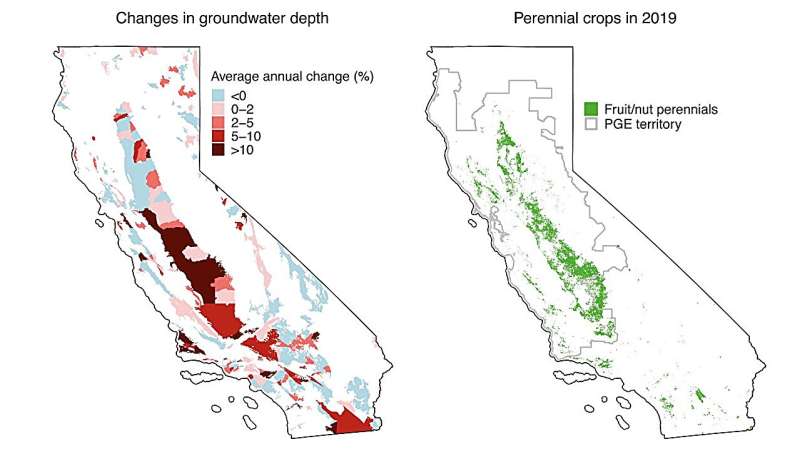This article has been reviewed according to Science X's editorial process and policies. Editors have highlighted the following attributes while ensuring the content's credibility:
fact-checked
trusted source
proofread
Irrigation tax could steer farmers from water-intensive crops

Your post-workout almond milk and fruit smoothie might one day leave your pocketbook significantly slimmer too, as water shortages in western U.S. states threaten to alter the price and availability of some types of produce.
A new University of Maryland-led study found that water conservation policies that raise the cost of irrigation for California farmers could result in them leaving agriculture or switching from perennial crops like fruit trees to annual crops like tomatoes.
The study reveals potential wide-ranging effects of controversial water taxes proposed under California's Sustainable Groundwater Management Act, which is designed to achieve groundwater sustainability by 2042.
The findings have important implications for policymakers in all western U.S. states, which are facing a water crisis and are struggling to develop policies that preserve critical water resources without gutting the agricultural economy. The study also helps illustrate the challenges of countries around the world in balancing water conservation with the need to feed growing populations amid the increasing impacts of climate change, the researchers said.
"Our study found that farmers will ride out short-term increases in the cost of water, like during a drought, but as cost increases become permanent, they shift away from crops like fruit trees, which are long-term investments" that produce high-value crops, but also have high water demands, said study co-author Louis Preonas, an assistant professor in the Department of Agriculture and Resource Economics.
California produces 18% of the total U.S. crop value, with a high percentage of specialty crops, Preonas said. That includes practically all of the almonds sold in the U.S., and 80% of those sold on the global market. Large-scale shifts away from almonds, which grow on fruit trees, could raise prices and have unintended downstream consequences throughout the economy.
But such shifts may be necessary to achieve the state's goals for water sustainability by 2024, the researchers said. For many years, California's robust agricultural production of fruits and other crops with high water needs has required farmers to extract more water from aquifers than is naturally replenished. With increasing heat and drought due to climate change, the future of the state's water supply is becoming increasingly fragile.
To understand how farmers would respond over the long term to policies that taxed water use, Preonas and his colleagues looked at California farmers' responses to changes in electricity prices between 2008 and 2019.
Although groundwater is free in most of California, it takes electricity to run the pumps that feed irrigation systems, so the researchers were able to use electricity prices as a proxy for a tax on water use. They estimated groundwater consumption on farms using data about groundwater levels, electricity usage and the energy needs of the specific pump equipment on each plot of agricultural land throughout California.
Their analyses showed that farmers responded to a 10% increase in groundwater cost with a 3.6% reduction in usage, primarily by shifting to less water-intensive crops. The study suggests that achieving California's sustainability targets would require a water tax of approximately 60%, which would lead to a shift in crops for 9% of farmland and increase the amount of land pulled out of farming every year by 50%.
"It seems very straightforward to say we want to manage the aquifer so we don't run out of water," Preonas said, "but there are these other effects you have to consider that have economic implications throughout the economy."
More information: Burlig F. et al. Groundwater and Crop Choice in the Short and Long Run. epic.uchicago.edu/research/gro … -short-and-long-run/
Provided by University of Maryland





















